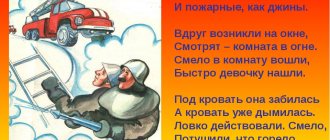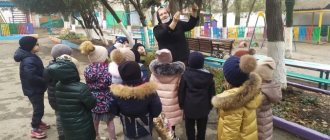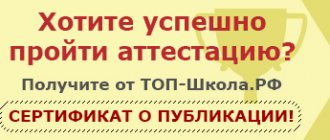Integrated and comprehensive classes
Integrated learning allows you to see and understand any phenomenon holistically; in kindergarten there is a subject-based learning system and it often turns out that knowledge remains scattered, artificially divided according to the subject principle, and as a result, children do not always holistically perceive the whole picture of the world around them.
Integrated classes are a combination of several types of activities. Complex classes within the framework of one topic solve different problems of children's development and are based on different types of activities. These classes can be carried out in all age groups, but they are especially useful with older preschoolers.
The section of the site, integrated and comprehensive classes in kindergarten for different groups, contains many interesting publications for educators on teaching children on various topics:
- Scenario for an integrated lesson in kindergarten
- Integrated lesson on application and ecology in kindergarten
- Summary of an integrated educational activity in kindergarten with children 3-4 years old
- Summary of an integrated educational activity with children 2–3 years old in kindergarten
- Lesson summary for younger children integrated lesson in junior group 2
- Synopsis of the integrated GCD preparatory group of kindergarten
- Summary of GCD in kindergarten
- Summary of an integrated lesson in the middle group of kindergarten
- Summary of an integrated lesson for Victory Day in kindergarten
- Summary of an integrated lesson in kindergarten with children of senior preschool age
- Summary of integrated organized educational activities
- Summary of an integrated lesson on cognitive-speech and artistic-aesthetic development of children in the second junior
- Integrated lesson in the preparatory group
- Summary of an integrated lesson on the Russian language and the surrounding world for a preparatory school group
- Integrated open lesson with children of the preparatory group
- Summary of an integrated lesson for the middle group of kindergarten
- Integrated open lesson
- Integrated lesson for the middle group
- Open integrated lesson on speech development, the environment and mathematics in the preparatory group of kindergarten
- Summary of an integrated lesson on ecology and speech development, senior mixed-age group
- Summary of integrated OOD in the senior group
- Summary of integrated OOD in the preparatory group
- Summary of an integrated lesson in kindergarten
- Summary of the final integrated lesson in the first junior group
The most important thing in integrated classes in a preschool educational institution is the unity of goals, understanding of the techniques, methods, tasks that determine the harmonious development of the child’s personality, in other words, the ability to “crawl”, “enter” the pedagogical process, without creating stress for children, literally physically reducing to level of their eyes and focusing, in organizing their work, on their right-hemisphere characteristics. A fundamentally important point in organizing integrated classes in preschool educational institutions will be the activation of all mental processes that ensure successful learning.
The modern direction of development of the educational system has affected all kindergartens in the country without exception. Now integrated classes in preschool educational institutions are considered popular and most effective. The Ministry of Education approves and encourages the comprehensive development of students, as evidenced by a number of recommendations from the Federal State Educational Standard. What are integrated classes? In general, training according to a similar principle involves the simultaneous development of the child.
Integrated lesson in kindergarten - combines knowledge from various educational fields, on an equal basis, complementing each other (for example: the concept of “autumn” is considered through the means of music, art, painting, ecology). At the same time, in such a lesson, the teacher solves several development problems.
An integrated lesson is an activity that is aimed at revealing the holistic essence of a certain topic through different types of activities, which are combined in the broad information field of the lesson through mutual penetration and enrichment.
Basics of integrated and comprehensive activities in kindergarten
All classes in kindergarten are divided into subject and meta-subject (or inter-subject). And if subject classes are narrowly focused classes, then a meta-subject class means a combination of different conceptual bases. That is, children in such classes develop the ability to consider the same concept from different points of view.
For example, a circle is a geometric figure, a circle is the core of a flower, a circle is a face (we took into account mathematics, the world around us and drawing).
Interdisciplinary classes, in turn, are divided into:
- integrated,
- complex,
- combined.
Combined classes are a combination of different forms of classes or different topics that have no relationship with each other. Example: first, children draw on an arbitrary topic, and then dance to music that has nothing to do with the topic of drawing. This activity is used to develop different skills of the child.
The conceptual boundary between integrated and complex classes is very vague, so many often replace one concept with another, which is not correct. An integrated lesson is a lesson that considers the topic holistically, combining several forms and methods of revealing focus through their mutual penetration into each other.
An integrated lesson is characterized by the development of associative connections between concepts. So, in this lesson, children begin to understand that the concept of “forest” is large, and when we pronounce it, it means a large number of trees, these trees will be different. The forest is a home for birds and animals. At the same time, the forest is a place where mushrooms and berries grow, which we can pick while walking. This means that the forest is a place for walking. In a deciduous forest it is lighter, and in a coniferous forest it is darker. During our walk we will see different forests at different times of the year. In the summer we will be able to listen to the sounds of the forest, and in the winter we will see in the snow traces of animals that live in the forest. This sequence of images, themes and terms forms an intellectual map, which the teacher necessarily draws for the children. At the same time, the concept of forest becomes multifaceted, broad and develops into a full-fledged image of a forest. But this is possible if children are already familiar with the concepts included in the mind map.
The teacher may not show the prepared mind map to the children, but conduct the lesson in such a way that such a map will become its result.
A full-fledged image is formed that allows the child, when the word “forest” is mentioned, to imagine a large number of different options for understanding this word. In this case, the number of activities and their precise change will not matter.
A complex lesson is a lesson that consistently combines different forms and methods of the educational process, united by a common theme. The theme will be present in all successively changing activities, accompanying them and helping to remember and understand the terms. But the main thing is to develop the students’ skills.
Comparing a complex and integrated lesson, it becomes obvious that the first does not go beyond the scope of the topic, and the second, with the help of related topics, reveals and complements the content of this topic
The content of complex and integrated lessons differs in that in an integrated lesson it is very difficult to divide the task into types of activities.
Source:
https://doshkolnik.ru/logopedia/7746-motorika.html
Table: comparison of comprehensive and integrated classes
| Complex | Integrated | |
| Focus | A comprehensive examination of the topic of the lesson with a special emphasis on the development of skills. | Holistic study of the material with the formation of an image. |
| Tasks |
|
|
| Techniques |
|
|
Open integrated and complex lesson for different age groups
To successfully conduct an integrated lesson, it is necessary that children already have a significant conceptual apparatus and different types of activities. At the same time, a complex lesson may contain elements of mastering an activity. Thus, the ability to discuss a topic gradually develops from many different activities where discussion is used as an activity. Preparation of a lesson begins with an adequate assessment of the students’ capabilities and the level of their activity skills.
At the age of 1.5 to 3 years, everything is just beginning:
- speech begins to form;
- vocabulary accumulates;
- coordination improves;
- games are becoming more diverse;
- images are formed, etc.
Not all children of the same age perceive the same material in the same way, but over time everyone will achieve a positive result
Children of the first junior group are more focused on integrated activities, and integrated ones are better used as a summary.
At the age of 3 years, the first significant psychological conflict arises - “I myself!” This is a time of self-awareness in society, a difficult period in a child’s life. Children's actions become intentional and varied. Arms and legs begin to obey the way you want - coordination of movements improves. Rhythm and poetry find an emotional response, and fantasies smoothly enter life based on the emerging visual and figurative thinking. In the second junior group, in addition to final integrated classes, 1–2 generalizing integrated classes can be held during the year.
The development of motor skills at the age of 3 years helps to improve a large number of skills, opening up new opportunities for children
With students in the middle group, we can already talk about conducting classes in the understanding that is typical for most adults. At this time, educational areas can be distinguished. For example, the world around us, elementary mathematical concepts, speech development, etc. At the age of 3 to 4 years, children begin to interact more actively with each other, and their own communication environment develops. Emotions appear and are expressed quite strongly. Friendly relationships develop, sympathy and empathy for peers arise. A sea of feelings and emotions sometimes overwhelms a child. At the same time, the baby is able to consciously remember the rules and follow them.
A 4-year-old child is able to correlate his actions and actions with the actions of his peers.
From the age of 4 years, socially significant skills are instilled, such as rules of conduct in certain places, etiquette, etc.
The age of 5–6 years is the time of why-cheek and big people. A lot can already be discussed with these children; they have their own opinions about a lot of things. Attention, memory and thinking are already under the child’s control, and he can consciously learn a poem for an event that is significant to him.
Games become more intense, roles become more meaningful, and children are able to assess the situation and solve the problem.
Age 6-7 years old - almost a schoolboy. The child has access to educational activities, he can control himself. New opportunities for intellectual activity become available to the baby. At this age, the opinions of others not only influence the child’s behavior at a particular moment, but also his actions in similar situations. The range of capabilities and skills is wide, so a small person can successfully master new concepts and entire sets of images. Children take part in theatrical performances with great pleasure.
More information about integrated and comprehensive classes in senior groups can be found in our article - Integrated and comprehensive classes in the senior group of preschool educational institutions.
A child can successfully complete work not only within the conditions set by an adult, but also creatively approach the given task.
Assessing the capabilities of children, we can say that for pupils 4 years old and older, integrated classes are recommended to be carried out in any quantity. The only question is the feasibility of a large number of such activities. It will be more effective to combine different forms of implementation. There can be no age restrictions: both complex and integrated classes can be successfully conducted.
Conducting an open integrated and comprehensive lesson in a preschool educational institution
Any open lesson is conducted according to general rules that are important to follow. Preparing an open lesson is painstaking work and a huge psycho-emotional load. After all, a person not only finds himself under meticulous and close attention, but also becomes the personification of the institution in which he works. Parents often correlate the institution with the personality of the teacher (which, of course, is wrong, but this is not felt at the time of the lesson). Each parent goes to an open lesson with their own expectations, and the teacher tries not to disappoint them. This is where the teacher must stop. The lesson is held for children, and parents are spectators. You shouldn’t try to please everyone and show everything at once.
A diagram of the basic rules for preparing an open lesson allows you not to lose sight of anything important
The teacher must understand that there are no trifles in this case. The simple absence of an extension cord will make it impossible to use some didactic or other material. It is also important to understand the fact that technical failures may occur. Therefore, it is necessary not only to check the equipment in advance, but also to think through the moments of possible failures in advance. If a child is sick and he has most of the required poem, then the lesson is also in danger of being disrupted.
When preparing an open lesson, think through possible unplanned moments. This will allow the teacher to get out of any situation with dignity.
Currently, Internet technologies are developing and opportunities are emerging for online broadcasting of open classes. In this case, the main thing is to position the camera correctly and conduct the lesson so that the children are in the frame the entire time.
When broadcasting online or demonstrating in a recording of an open lesson, there are a number of obvious advantages:
- Eliminates the preparation of materials for parents and their notification and instruction, which allows you to devote more time to working on the lesson itself.
- Allows educators to avoid difficult situations with parents. Especially in those moments when parents try to help their child cope with a task, mistakenly assuming that he cannot do it.
- Children are not distracted by the presence of strangers.
- Subsequently, the video recording allows you to competently and comprehensively analyze the lesson.
- The lesson takes place in a familiar environment for children.
- The parent has the opportunity not only to observe his child at the moment, but also to save the recording in the archive for a long memory.
Final open lesson
A distinctive feature of the final classes is that they should clearly demonstrate to both children and adults what they managed to learn during the reporting period. In kindergarten, such classes are most often held at the end of each semester. It would be a big mistake to try to create a lesson out of everything that you managed to teach your students. It is best to take as a basis a topic (in this case it will be more convenient to use a complex form) or a section (an integrated lesson is suitable here) and collect those forms that are most effective for the entire group. We must not forget that personal achievements and group achievements are different concepts. In an open lesson, the teacher shows the work of the group as a whole, and not of individual children.
Logical and correctly selected material is the basis of a good open final lesson
Another mistake would be starting incorrectly. If you have chosen a topic, then you should not try to make an integrated lesson out of it, it is better to make a high-quality comprehensive one. If the concept and its consideration from the points of view of different topics were taken as a basis, then special attention should be paid to a logical and consistent presentation.
Structure and timing of the lesson
When preparing any lesson, SanPiN rules apply, which clearly regulate the duration of the event. Considering that open, integrated and complex classes are recommended for children aged 3–4 years and older, the duration of such a lesson can vary from 15 minutes in the second youngest group to 30 minutes in the preparatory group.
You can learn more about integrated and comprehensive classes in the senior group from our article - Integrated and comprehensive classes in the senior group of preschool educational institutions.
The rules and regulations of SanPiN take into account all the psychophysiological characteristics of children of different ages, so it is undesirable to violate them
The structure of any lesson in a preschool educational institution consists of 3 successive stages:
- Introductory part - 2–5 minutes. The teacher shows the children something bright, interesting, and exciting.
- The main part is 12–25 minutes. Includes several activities and a music or physical education break.
- The final part is 2–5 minutes. Summing up and reflection.
In order to conduct an integrated lesson, several different classes can be combined (for example, educational, musical, physical education, etc.). In this case, one type of activity should not exceed the interval recommended by regulatory documents and there must be an alternation of dynamic and static moments.









